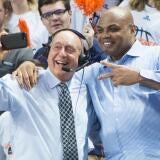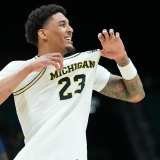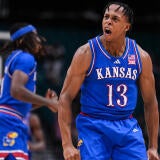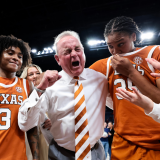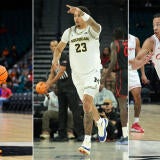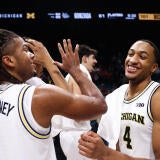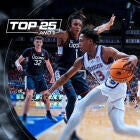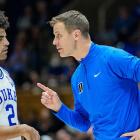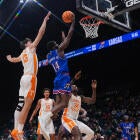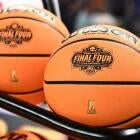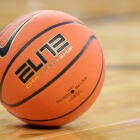Five things we learned from spending five days with Florida coach Todd Golden on the recruiting trail
CBS Sports' Matt Norlander gives the lowdown on what he saw behind the scenes in late July with the Gators
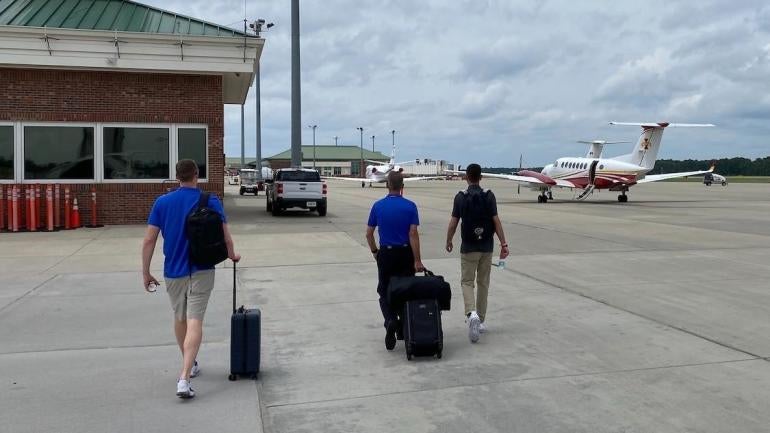
We recently published a two-part deep dive that got into the nitty-gritty -- and lavish luxury -- of what it's like to recruit at a prestigious power-conference program. Florida coach Todd Golden allowed me to shadow him and his staff over a five-day spell for the entirety of the pivotal late-July live period.
If you've not read both pieces, Part I can be found here and Part II here.
Given the rare nature of the assignment, I wanted to peel back a few more layers about the experience, how Golden is choosing to run Florida's men's basketball program and share some takeaways on the state of basketball recruiting in 2022.
1. Golden's recruiting gambit
Many head coaches (though not all, based on conversations I've had this summer) are dialing back their emphasis on high school recruiting and accepting the fact that they'll need to work the transfer portal in order to successfully keep their roster annually stocked with talent. Golden is a bit different in that he so transparently is putting out there what his blueprint is to get Florida back to sustained national relevancy.
"In college, it makes way more sense to sign free agents, which are transfers, than to just 'draft' guys and hope you hit on them," Golden told me aboard UF's private plane.
To "draft" players in college was in reference to loading up on high school prospects. It's not that Florida isn't recruiting 16- and 17-year-olds. It is. But the number of kids Golden is recruiting is on the low end compared to a lot of other programs that are at or near Florida's level.
In the days since both stories published I've heard from a few coaches who were surprised Golden spoke openly about his strategy. Some coaching staffs consider the way they recruit to be classified information. For Golden to speak out on his recruiting reconnaissance, it can obviously be used against him. As the pieces detail, Golden is mostly focused on recruiting five-star players or higher-end four-star players, then waiting the cycle out. Don't expect Florida to fill up its scholarship roster or to find clarity for its 2023 class by this November. Future Gators won't be known until the spring of 2023.
Part of this is by his design, part of it is the environment of college sports now. Either way, this was not the way coaches ran programs as recently as five-plus years ago.

2. The gap in spending grows wider
Not exactly a shocking revelation here, but the have-vs.-have-nots state of affairs in college sports is worth reiterating. Florida allots approximately $2.5 million in expenses for its men's basketball program each year. That's not the most in the country, but it comfortably registers in the top tier. For comparison, I asked people at three other programs how much they spend. One school was on the West Coast, another two in the Midwest. All three in different conferences. Florida comfortably beats all three, one of which is public (like UF), two of which are private.
The private planes help significantly. Florida owns two of them, which is something maybe 30 other programs can match. While plenty of schools rent planes (or get rich boosters to loan them out), owning two air recruiting vessels 15 minutes from campus with the capacity to go anywhere in the country on minimal notice (the school has at least four full-time pilots) is a luxury that is considered a mandate in the SEC.
By owning the planes, Florida only pays for fuel and maintenance on the aircrafts. Each trip Golden takes winds up saving him hours upon hours at a time vs. flying commercial and dealing with all the necessary measures and wait times that come with everyday travel.
Recruiting is an ever-lingering burden, for sure, but make no mistake: The way the college sports machine is built, recruiting to Florida is not at all the same the way guys at mid- and low-majors are going about their business. Those coaches are grinding in the truest sense of the word, fighting for every morsel they can get to land players. At Florida, it's more like a buffet.
When it comes to how UF is able to recruit compared to what Golden was doing at San Francisco a year ago, they aren't in the same solar system. With the SEC and Big Ten set to expand to 16 teams in the coming years -- and to have record-breaking media rights deals alongside those expansions -- the chasm between programs' resource capabilities will become canyon-sized.
3. NIL didn't come up much
Florida has a collective for NIL that's gaining some traction around Gainesville, but best I can tell, its energy and purpose is primarily directed to help football at this point. Golden told me Florida lost out on multiple transfers in April and May because the program is not recruiting with NIL at the forefront of the discussion.
That's not the case at a lot of other places.
Some players asked Golden how much earning opportunity there would be, but Florida's still building its NIL strategy. It's also still waiting on how the boundaries could change once the transformation committee puts forth its new legislation recommendations in the coming months. Golden told me Florida wouldn't promise a single dollar to a prospect. In turn, a few players who were initially interested in the Gators wound up looking more seriously at other programs.
That's not to say Florida's players won't benefit and earn money via NIL opportunities. They absolutely will. But to hear Golden market his program, he's not that interested in bringing in guys who have NIL at the top of their list for reasons to transfer. I don't know if it stays this way, but it was interesting to learn.
4. Takeaway from practice: Gators have Big Dance potential
The end of Part I and the beginning of Part II has scenes from Florida's team practice and early morning workout session. Golden opted for something very few other coaches did in July: he left the trail for almost 24 hours to be with his team. I didn't realize this was going to be the case when I took on the assignment, but I'm happy he did it because it provided me an early peek at these new-look Gators. Six transfers are on this roster. And yes, it's hard to truly tell, in July, how good a team forecasts to be seven months into the future.
I will say: the energy and camaraderie of Florida's players gave off the vibe of a highly competitive in-season practice. I was basically a fly on the wall (I don't think some players even noticed I was there) and it felt like the middle of January.
After seeing 11 of Florida's 13 players up close (two aren't on campus yet), it seems fair to project this team in the 30-45 range heading into next season. Colin Castleton may well be a top-25 player next season, and Golden told me St. Bonaventure transfer Kyle Lofton might wind up as the best point guard in the country. Another good returning Gator is Myreon Jones, who figures to be a double-digit scorer. UF has a potential future pro in LSU transfer Alex Fudge, though he's probably a two-year work-in-progress. Elsewhere, hopes couldn't be higher for Belmont transfer Will Richard.
I'd say a reasonable window for Florida is finishing between fifth and eighth in the SEC. It would be a letdown if this team fails to hit 20 wins.

5. The story behind the story
It was in late May when I pitched doing a summer recruiting story that wasn't Peach Jam-focused. The notion of embedding with a program and getting a full-blown look at a staff's recruiting philosophy was enticing.
Would anyone go for it?
Saying yes to an assignment like this requires coaches to let their guard down in the presence of a reporter, but they also have to agree to essentially have everything be on the record or observed on background, which is tricky considering that coaches can't, by rule, be quoted talking about unsigned prospects. It's a situation some wouldn't consent to.
I considered five coaches/programs to ask for this access. Golden/Florida was No. 1 on the list because of how good of a job Florida is, combined with the unknowns of Golden taking over a big program and having a power-conference job for the first time -- at 37 years old. Plenty of coaches wouldn't have agreed to do this. And if they had, maybe their bosses would have advised against it. Golden and Florida thought differently, seeing an obvious opportunity to get significant media coverage in the middle of the offseason. For them, there was nothing to hide and the upside was big enough that it was worth letting everyone get an inside look at how they're running shop down in Gainesville.
But don't mistake coverage for accomplishment. As Part II makes reference to, Golden has his share of skeptics. In fact, in the days following the stories getting published, I heard from a few more people who expressed some playful cynicism over what Golden has done to justify getting so much publicity. But this story wasn't done because I think Florida is destined to return to top-10 status nationally. I have no idea. Maybe this will flame out. That was part of what made this situation intriguing. Golden made for a compelling central figure specifically because he has not yet proven he can do this at a big school. His WCC record was 23-22 and he never beat Gonzaga as a coach.
When you get one of the best jobs in the sport and you're years away from turning 40, how do you handle that kind of responsibility? How do you choose to take your first year and build out a roster? Putting a spotlight on Sean Miller's second chance at Xavier or Kenny Payne's big opportunity at Louisville or Jerome Tang's first crack at being a head coach at K-State would have also been illuminating. Each coach has a different situation and story to tell.
I wasn't sure what I was going to get with Golden, but figured the voyage would be worthwhile. And it was. College sports fans grow more knowledgeable and engaging with each passing year re: how their basketball and football programs recruit. Offseasons are seasons unto themselves, even if most of what happens isn't much seen by the general public. To better understand how schools recruit, how coaches talk about prospects and how they prioritize players, a story like this -- from the ground level, right alongside the head coach -- is one of the best ways to grasp how a program is assembled.
Golden gave as honest a view as anyone could expect in this uncertain new era of college sports.


